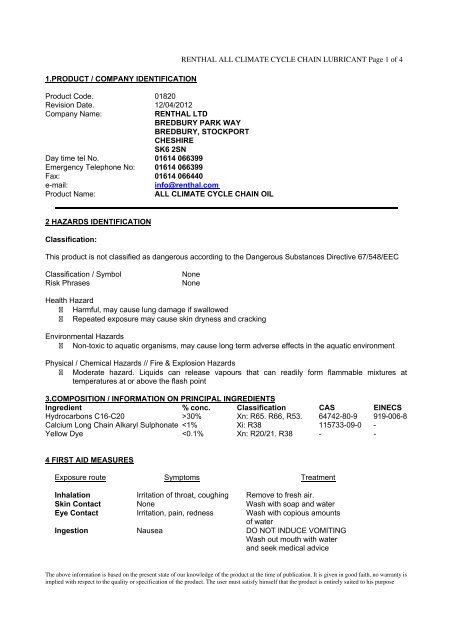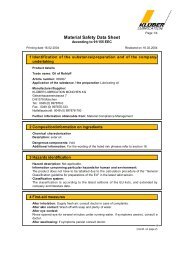RENTHAL ALL CLIMATE CYCLE CHAIN ... - Ison Distribution
RENTHAL ALL CLIMATE CYCLE CHAIN ... - Ison Distribution
RENTHAL ALL CLIMATE CYCLE CHAIN ... - Ison Distribution
You also want an ePaper? Increase the reach of your titles
YUMPU automatically turns print PDFs into web optimized ePapers that Google loves.
1.PRODUCT / COMPANY IDENTIFICATION<br />
Product Code. 01820<br />
Revision Date. 12/04/2012<br />
Company Name:<br />
<strong>RENTHAL</strong> <strong>ALL</strong> <strong>CLIMATE</strong> <strong>CYCLE</strong> <strong>CHAIN</strong> LUBRICANT Page 1 of 4<br />
<strong>RENTHAL</strong> LTD<br />
BREDBURY PARK WAY<br />
BREDBURY, STOCKPORT<br />
CHESHIRE<br />
SK6 2SN<br />
Day time tel No. 01614 066399<br />
Emergency Telephone No: 01614 066399<br />
Fax: 01614 066440<br />
e-mail:<br />
Product Name:<br />
info@renthal.com<br />
<strong>ALL</strong> <strong>CLIMATE</strong> <strong>CYCLE</strong> <strong>CHAIN</strong> OIL<br />
2 HAZARDS IDENTIFICATION<br />
Classification:<br />
This product is not classified as dangerous according to the Dangerous Substances Directive 67/548/EEC<br />
Classification / Symbol<br />
Risk Phrases<br />
None<br />
None<br />
Health Hazard<br />
Harmful, may cause lung damage if swallowed<br />
Repeated exposure may cause skin dryness and cracking<br />
Environmental Hazards<br />
Non-toxic to aquatic organisms, may cause long term adverse effects in the aquatic environment<br />
Physical / Chemical Hazards // Fire & Explosion Hazards<br />
Moderate hazard. Liquids can release vapours that can readily form flammable mixtures at<br />
temperatures at or above the flash point<br />
3.COMPOSITION / INFORMATION ON PRINCIPAL INGREDIENTS<br />
Ingredient % conc. Classification CAS EINECS<br />
Hydrocarbons C16-C20 >30% Xn: R65. R66, R53. 64742-80-9 919-006-8<br />
Calcium Long Chain Alkaryl Sulphonate
<strong>RENTHAL</strong> <strong>ALL</strong> <strong>CLIMATE</strong> <strong>CYCLE</strong> <strong>CHAIN</strong> LUBRICANT Page 2 of 4<br />
5 FIRE FIGHTING MEASURES<br />
SUITABLE EXTINGUISHING MEDIA<br />
Dry Powder, Water Fog, CO 2 and Foam DO NOT USE WATER.<br />
SPECIAL EXPOSURE HAZARDS<br />
The substances arising from the thermal decomposition of this product will depend largely upon the<br />
conditions bringing about decomposition. Any of the following may be expected.<br />
Carbon Dioxide<br />
Polycyclic Aromatic Hydrocarbons<br />
Carbon Monoxide<br />
Unburnt Hydrocarbons<br />
Water<br />
Unidentified Organic and Inorganic Compounds<br />
Particulate Matter<br />
Hydrogen Sulphide<br />
SPECIAL PROTECTIVE EQUIPMENT<br />
For large fires consider fire tunics (EN469), wet leg trousers (EN469), Wellington boots (EN345 Part ll<br />
1996), helmet (EN443), flashhood (EN531), gloves (EN323), self-contained breathing apparatus (EN137),<br />
self-contained breathing apparatus with airline attachment (EN139) .<br />
6 ACCIDENTAL RELEASE MEASURES<br />
PERSONAL PRECAUTIONS<br />
Not classified as flammable but will support combustion. Remove sources of ignition.<br />
Protective equipment may include PVC, Neoprene or nitrile rubber gloves; rubber knee-length safety boots<br />
and PVC jacket and trousers. Avoid contact with eyes and skin.<br />
ENVIRONMENTAL PRECAUTIONS<br />
If the product has contaminated any land it may require excavation of contaminated soil. If the product has<br />
entered a water course or stream use absorbent booms to prevent further contamination.<br />
CLEANUP PROCEDURE<br />
Large spills should be bunded with sand or earth. The liquid should be reclaimed directly or in an<br />
absorbent medium and then transferred to clearly marked containers and disposed of in accordance with<br />
local by-laws and the requirements of the Environmental Protection Act.<br />
Small spills should be absorbed in a suitable material and disposed of as for large spills.<br />
7 HANDLING AND STORAGE<br />
HANDLING<br />
Impervious gloves and overalls where regular contact is likely, and goggles if there is a risk of splashing.<br />
Recommended Procedures – avoid prolonged contact with skin<br />
STORAGE<br />
Keep at temperatures not exceeding 30 -40 C. Protect from extremes of temperature, and protect from<br />
ingress of contaminants by keeping the contained closed or by maintaining a product seal around the cap<br />
8 EXPOSURE CONTROLS<br />
U.K. WORKPLACE EXPOSURE STANDARDS 2003<br />
5 mg/M 3 8 hour TWA value<br />
10 mg/M 3 15 min TWA value<br />
Reference should be made to the HSE’s publication Methods for the Determination of Hazardous<br />
Substances (MDHS) 84 – Measurement of Oil Mists from mineral based metalworking fluids.<br />
Respiratory protection (eg breathing apparatus or fume extraction) may be required when handling heated<br />
The above information is based on the present state of our knowledge of the product at the time of publication. It is given in good faith, no<br />
warranty is implied with respect to the quality or specification of the product. The user must satisfy himself that the product is entirely suited to<br />
his purpose
<strong>RENTHAL</strong> <strong>ALL</strong> <strong>CLIMATE</strong> <strong>CYCLE</strong> <strong>CHAIN</strong> LUBRICANT Page 3 of 4<br />
material. Half masks (EN149) or valved half masks (EN405) in combination with type A2 (EN141) and<br />
P2/3 (EN143) prefilters may be considered when the liquid is at ambient temperatures, when at elevated<br />
temperatures then consider half masks (EN149) or valved half masks (EN405) in combination with type<br />
AX (EN371) and P2/3 (EN143) prefilters.<br />
Where repeated hand contact is likely wear suitable impervious gloves and wash with soap and water.<br />
Suitable gloves are Nitrile.<br />
Any contaminated clothing should be removed and laundered before reuse.<br />
Where there is a risk of splashing, suitable goggles should be worn conforming to BS EN 166 345B<br />
Environmental controls<br />
Users should be aware of environmental considerations and their duties under the Environmental<br />
Protection Act. Further advice may be found on various government websites eg<br />
www.dti.gov.uk/access/index.htm and www.envirowise.gov.uk<br />
9 PHYSICAL AND CHEMICAL PROPERTIES<br />
Appearance:<br />
Clear Yellow Liquid<br />
Odour:<br />
Perceptible<br />
Acidity/Alkalinity<br />
not applicable<br />
Initial boiling point<br />
>150 C<br />
Pour Point<br />
100 C<br />
Vapour pressure @20 C<br />
MSDS <strong>ALL</strong> <strong>CLIMATE</strong> <strong>CYCLE</strong> <strong>CHAIN</strong> LUBRICANT Page 4 of 4<br />
12 ECOLOGICAL INFORMATION<br />
AIR<br />
The product is a mixture of non-volatile components which are not expected to be released to air in any<br />
significant quantities.<br />
WATER<br />
The product will form a floating layer on the surface and its components will not evaporate or dissolve to<br />
any great extent. Dissolved components will be absorbed in sediments. In aerobic waters and sediments<br />
they will biodegrade slowly, but in anaerobic conditions they will persist. The product is practically nontoxic<br />
to aquatic organisms but contains components which have a high potential to bio-accumulate.<br />
SOIL<br />
Small volumes released on land will be absorbed in the upper soil layers and be biodegraded slowly.<br />
Larger volumes may penetrate into anaerobic soil layers in which the product will persist and may reach<br />
the water table on which it will form a floating layer. The more soluble components may dissolve but their<br />
high soil absorption coefficient and low solubility will prevent significant contamination of ground water.<br />
13 DISPOSAL CONSIDERATIONS<br />
Substance via authorised waste disposal contractor to an approved waste disposal facility observing<br />
all local and national regulations<br />
Container<br />
As substance<br />
14 TRANSPORT INFORMATION<br />
UN NUMBER<br />
PRIMARY HAZARD<br />
SUBSIDIARY HAZARD<br />
PACKING GROUP<br />
EMERGENCY ACTION CODE<br />
PROPER SHIPPING NAME<br />
CLASS<br />
Not dangerous for conveyance<br />
15 REGULATORY INFORMATION<br />
Supply label details Ref CHIP 3<br />
Label Name<br />
None<br />
Symbols<br />
None<br />
Risk Phrases R53 – May cause long term adverse effects in the aquatic environment<br />
R66 Repeated exposure may cause skin dryness and cracking<br />
Safety Phrases<br />
16 OTHER INFORMATION<br />
Users should be trained in good industrial hygiene practices.<br />
The above information is based on the present state of our knowledge of the product at the time of publication. It is given in good faith, no<br />
warranty is implied with respect to the quality or specification of the product. The user must satisfy himself that the product is entirely suited to<br />
his purpose





